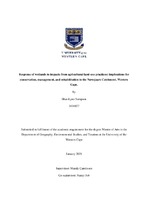| dc.contributor.advisor | Carolissen, Mandy | |
| dc.contributor.author | Sampson, Shae-Lynn | |
| dc.date.accessioned | 2021-04-07T08:22:26Z | |
| dc.date.available | 2021-04-07T08:22:26Z | |
| dc.date.issued | 2021 | |
| dc.identifier.uri | http://hdl.handle.net/11394/8154 | |
| dc.description | Magister Artium - MA | en_US |
| dc.description.abstract | Wetlands occupy about 6% of the world’s surface and are fragile ecosystems that support a diversity of plants and animals. Wetlands are increasingly recognised for their role in the provision of ecosystem services and contribution to global biodiversity. Despite this, more than half of the world’s wetlands have vanished or been degraded, primarily due to agriculture. Wetlands are constantly adjusting to disturbances occurring within them and within their surrounding landscape. It is important to recognise to what extent various disturbances affect wetlands when assessing disturbance and impact, and when considering wetland protection options. The benefit of the detailed characterisation of the sub-catchments of the Nuwejaars catchment is deepened understanding of how different combinations of land-uses and soils impact catchment hydrology, and ultimately, the wetlands within the catchment | en_US |
| dc.language.iso | en | en_US |
| dc.publisher | University of the Western Cape | en_US |
| dc.subject | Wetland vulnerability | en_US |
| dc.subject | Wetland catchment | en_US |
| dc.subject | Agriculture stressor index | en_US |
| dc.subject | Land-use | en_US |
| dc.subject | Wetland type | en_US |
| dc.title | Response of wetlands to impacts from agricultural land-use practices: Implications for conservation, management, and rehabilitation in the Nuwejaars Catchment, Western Cape. | en_US |
| dc.rights.holder | University of the Western Cape | en_US |

